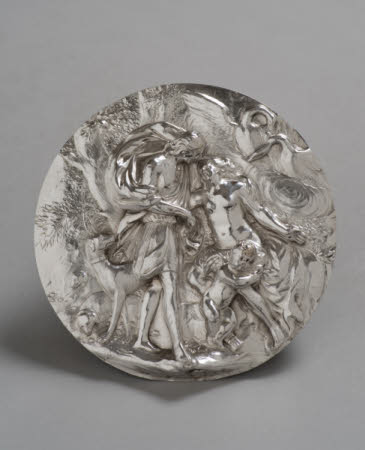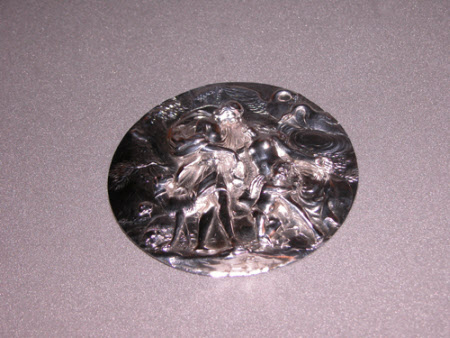Venus and Adonis
Dutch School
Category
Art / Sculpture
Date
circa 1650
Materials
Silver
Measurements
131.6 mm (Diameter)
Place of origin
Netherlands
Order this imageCollection
Anglesey Abbey, Cambridgeshire
NT 517357
Summary
Silver, Venus and Adonis, Netherlandish, c. 1650. A circular cast and chased silver relief depicting Venus and Adonis. The goddess Venus, naked, is seated upon a small hillock, her son Cupid at her feet. She implores her lover Adonis, who stands before here, dressed in a short tunic and billowing cloak, not to depart for the hunt, after she has had a premonition that he will be killed. Three of Adonis’s hounds at the left; at top right are a pair of swans. As he rests against his mother’s leg, Cupid appears to be sleeping, oblivious to the unfolding drama above him. The reverse has in the centre a soldered screw element, which would have been used to fix the relief into the centre of a larger object such as a dish (tazza). The relief reflects the style of the van Vianen family of silversmiths who worked in Utrecht in the Netherlands, but seems to be the work of an anonymous Dutch silversmith active around the middle of the 1600s.
Full description
This beautifully fluent and highly pictorial silver relief depicts the story of the fatal passion of Venus, goddess of love, for the young huntsman Adonis. One of the most famous tragic love stories from ancient mythology, a perennially popular theme for artists from the Renaissance onwards, it is recounted in the Roman poet Ovid’s Metamorphoses. Born from the incestuous union of King Cinyras of Paphos with his daughter Myrrha, Adonis became famed for his extraordinary beauty. Accidentally receiving a scratch from one of her son Cupid's arrows, the goddess of love Venus herself tumbled passionately into love with Adonis, becoming oblivious to everything except her obsessive feelings for the young man (Metamorphoses, X, 516-59). Although she accompanied him on his hunting expeditions, Venus begged Adonis to beware the strength and violence of wild beasts. However, ignoring her warnings, he was gored to death by a fierce wild boar, dying in the arms of the grief-stricken goddess, who turned his blood into the anemone flower (Metamorphoses, X, 702-39). The principal scenes from the story that are depicted in art are the leave-taking of the two lovers, and Venus’s subsequent lamentation over the dead Adonis. Both scenes are depicted in silver medallions forming the centres of two tazze made in 1623 and 1624 for the Guild of St Sebastian in Alkmaar in the Netherlands, in the Municipal Museum in Alkmaar ((J.W. Frederiks, Dutch Silver. Embossed Plaquettes, Tazze and Dishes from the Renaissance until the end of the eighteenth century, Vol. I, The Hague, 1952, pp. 11-13, nos. 7 & 8). The scene of the parting is here rather more tenderly portrayed than it is in the slightly earlier bronze statuette at Anglesey Abbey, by Giovan Francesco Susini (NT 515032), which emphasises the brutal impatience of the cocksure young man to be on his way to the further pleasures of the hunt. In the small silver relief, in contrast, the lovers embrace, with Adonis attempting to reassure the distraught Venus. One of his hounds turns its head though, as if to urge its master to hurry up. A pair of swans is seen at right. The beauty of the swan made it an attribute of the goddess Venus, who is sometimes shown in a chariot being drawn by a pair of the birds. Here they seem like Adonis’s hound to comment on the scene of the lovers’ parting, one of the swans reaching towards Venus, as if to warn her that she too must be on her way. The relief therefore captures the tender intimacy of the lovers’ leave taking, whilst at the same time injecting a strong sense of disquiet, through the impatient animals, but also through the billowing draperies and whirling clouds. The fluent modelling and extremely careful chasing of the surfaces of the silver are admirable. The relief would certainly originally have been the central medallion within a larger piece of silver, probably some form of footed bowl (tazza). Stylistically it seems to have been made in the Netherlands, probably around the middle of the seventeenth century. It reflects the influence of the Van Vianen dynasty of goldsmiths, who originated in Utrecht, and whose principal members, Adam van Vianen (1568-1627), his brother Paulus (c. 1570-1610) and son Christiaen (c. 1600-67), pushed forward the boundaries of late Mannerist design, promoting the new auricular style in goldsmiths’ work, with its use of irregular and flowing fleshy scrolls and lobe-like forms. Paulus van Vianen in particular made outstanding figurative compositions which were used for the centres of dishes or tazze, but also circulated as independent plaquettes, today surviving mainly in examples in bronze or in lead. Paulus’s most extensive plaquettes series consisted of a series of at least twelve large circular reliefs depicting episodes from Ovid’s Metamorphoses. Eleven, the largest known group, were recorded in the collection of King Charles I at Whitehall Palace in 1639 (Jeremy Warren, Medieval and Renaissance Sculpture in the Ashmolean Museum, Oxford, 3 vols., Oxford 2014, IIII, pp. 732-33, pp. 1006-14, nos. 477-81). Today four lead examples are in the Ashmolean Museum, Oxford, whilst another four in gilt-bronze, in the Bankes collection at Kingston Lacy (NT 1255222.1-1255222.4), might have come from Charles I’s collection. Van Vianen’s beautiful mythological plaquettes do not, perhaps surprisingly, include the popular subject of the Venus and Adonis. It is possible that the relief now at Anglesey Abbey, rather smaller in diameter than Paulus van Vianen’s series of roundels from Ovid, reflects a lost design by the artist. His reliefs were extensively copied, no doubt often pirated, by goldsmiths in Holland, Germany and elsewhere. For example, a plaquette of Diana and Callisto made in the Netherlands around the middle of the seventeenth century is a loose copy of Paulus van Vianen’s original plaquette of this subject (Frederiks, Dutch Silver, p. 419, no. 296; for van Vianen’s original design, p. 142, no. 84). The vigorous and fluent handling of the Venus and Adonis relief, more baroque than van Vianen’s own late Renaissance style, compares well with that of the copy of the Diana and Callisto. Jeremy Warren 2019
Provenance
Purchased by Urban Huttleston Rogers Broughton, 1st Lord Fairhaven (1896-1966) from David Black on 14 November 1946, for £14; bequeathed to the National Trust by Lord Fairhaven with the house and the rest of the contents.
Credit line
Anglesey Abbey, The Fairhaven Collection (The National Trust)
Makers and roles
Dutch School, sculptor

